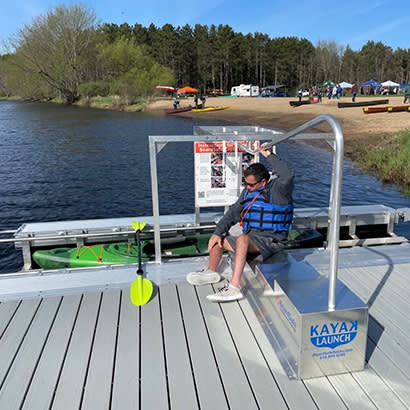
For an enhanced digital experience, read this story in the ezine.
When you enter a kayak and push off into a river or stream and propel around a body of water, nature surrounds you at every level. Paddling and exploring the water bring families and friends together, connect people to nature, and promote exercise and wellness. Kayaking is an activity that almost anyone can participate in — young and old, novice and experienced, and people with mobility limitations and physical disabilities. It’s easy to understand why the popularity of paddle sports continues to grow.
The Benefits of an Adaptive Kayak Launch
For paddlers with disabilities, paddling offers rehabilitation and socialization. Adaptive paddlers describe the freedom of leaving their wheelchairs and transitioning into a kayak as “liberating.” While there have been steady improvements in Americans with Disabilities Act (ADA) accessibility at parks and recreational facilities, most water access points continue to be designed with minimum ADA standards and assistive features, excluding paddlers with moderate to severe disabilities from participating.
More important than the number of access points at recreational facilities is the quality of the accommodations offered at launch sites. All too often locations deemed accessible cannot be used by paddlers who require additional features. Ultimately, the goal is to enhance the paddling experience for everyone on the water.
The Three Most Common Challenges Faced by Adaptive Paddlers
- Kayak launches are designed by individuals with limited understanding of the additional features paddlers with disabilities require to enter and exit paddling vessels safely.
- Barriers to participation are not recognized and are overlooked.
- Additional features required by adaptive athletes are missing or not developed to the extent necessary, creating additional barriers that result in the need for lifting, tugging or pulling, as well as the possibility of tipping over and possible injury to paddlers and volunteers.
Simply put, accessible and adaptive are not synonymous when it comes to accessing the water for paddling or kayaking. Launches designed with minimum standards of accessibility often will exclude paddlers who need additional adaptive features the most. This oversight is never the intention of parks, communities and municipalities looking to create universal access, but sadly it happens. Accessible features will get you to the water, and adaptive features will get you into the water.
If gaps in diversity, equity and inclusion are to be bridged, the best solutions should come from paddlers who understand the barriers to inclusion. While there is no one launch that will serve 100 percent of paddlers’ needs or remove 100 percent of the barriers, education, understanding and improved access points with additional adaptive features will enhance the paddling experience for most paddlers.
Ensuring Inclusivity
How can park and recreation professionals, architects, engineers and community stakeholders ensure their kayak launch has adaptive features that include the widest range of users?
- Design kayak and canoe launches with adaptive paddlers in mind.
- Educate themselves and others about the adaptive features that will enhance the paddling experiences for adaptive paddlers and all users of the launch.
- Understand accessible launches may look good to able-bodied paddlers, but may end up excluding, rather than including, paddlers with disabilities due to the lack of adaptive features, incorrectly designed features or overlooked barriers.
The greatest difficulty reported by most paddlers is getting in and out of their vessels. Upon entry, kayaks and canoes can tip, shift or roll over. Adaptive features can ensure safe access in and out of the water and allow paddlers with disabilities to independently enter and exit their vessel. As recreation stakeholders, we all share responsibility for shaping the future of our country’s outdoor spaces, supporting an inclusive lifestyle and improving quality of life for all.
Lori Limpar is Content Manager at BoardSafe Docks.

